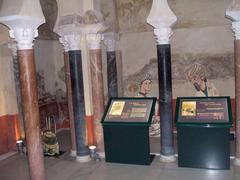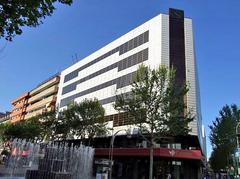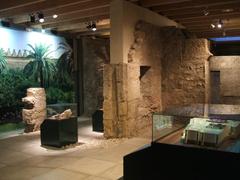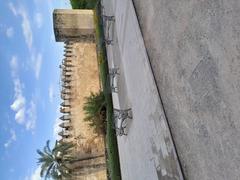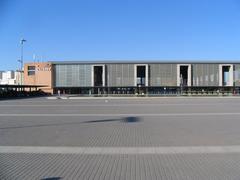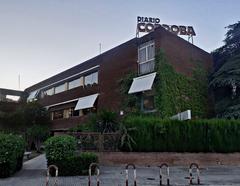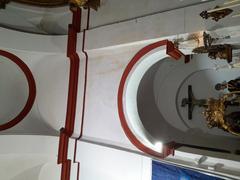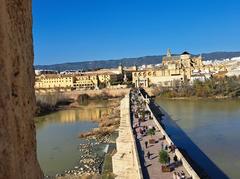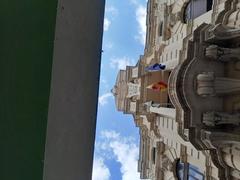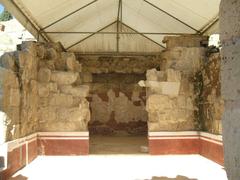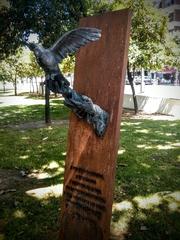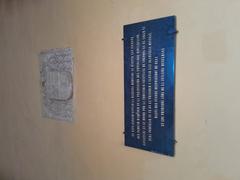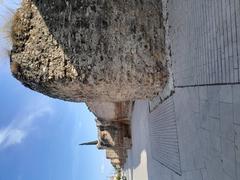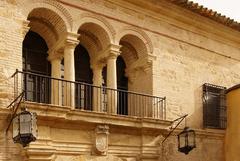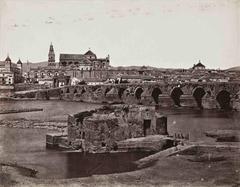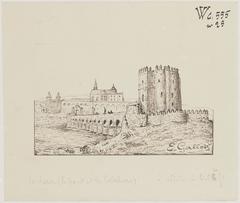Alcázar de los Reyes Cristianos Córdoba, Spain: Visiting Hours, Tickets, and Historical Sites Guide
Date: 14/06/2025
Introduction
The Alcázar de los Reyes Cristianos stands as a striking symbol of Córdoba’s rich and layered history. This fortress-palace, located on the banks of the Guadalquivir River and close to the city’s famed Mosque-Cathedral, reflects the confluence of Roman, Visigothic, Islamic, and Christian civilizations. Over its two millennia of existence, it has served as a Roman residence, a Visigothic stronghold, a sophisticated Umayyad palace, a Christian royal court, and even the seat of the Spanish Inquisition. Today, the Alcázar is a UNESCO World Heritage Site and a must-see for anyone interested in Spanish history, architecture, and culture (mezquitadecordoba-entradas.org; en.wikipedia.org).
This comprehensive guide will walk you through the Alcázar’s historical evolution, architectural highlights, visiting hours, ticketing options, accessibility, guided tours, nearby attractions, and practical tips to make your visit seamless and enriching.
Table of Contents
- Roman and Visigothic Foundations
- Islamic Era: Umayyad and Caliphal Splendor
- Christian Reconquest and Medieval Transformation
- The Catholic Monarchs and the Spanish Inquisition
- Later Uses: Prison, Restoration, and Heritage
- Architectural and Artistic Highlights
- Visiting Information: Hours, Tickets & Accessibility
- Guided Tours, Special Events & Nearby Attractions
- Photography Tips
- Frequently Asked Questions (FAQ)
- Enduring Significance and Conclusion
- References
Roman and Visigothic Foundations
Archaeological research reveals that the Alcázar’s origins date back to the Roman era, when the site served as a governor’s residence and customs post. Remnants of Roman mosaics and third-century sarcophagi can still be seen in the Hall of Mosaics, attesting to its early significance (mezquitadecordoba-entradas.org). After the decline of Roman power, the Visigoths repurposed the site as a fortress, laying the groundwork for subsequent transformations (en.wikipedia.org).
Islamic Era: Umayyad and Caliphal Splendor
With the arrival of the Umayyads in the 8th century, the Alcázar was transformed into an elegant palace complex. The palace was celebrated for its grand baths, lush gardens irrigated by ingenious watermills, and the largest library of its time in the Western world (spottinghistory.com). Many elements of the original Islamic gardens and water engineering remain visible today, offering visitors a glimpse into the sophistication of Al-Andalus (en.wikipedia.org).
Christian Reconquest and Medieval Transformation
In 1236, King Ferdinand III of Castile captured Córdoba, marking a pivotal chapter in the Alcázar’s history. The fortress was rebuilt by Alfonso X and Alfonso XI in the 14th century, blending military architecture with Mudéjar decorative elements—a fusion of Christian and Moorish styles. This period saw the construction of the iconic towers and the modernization of the fortress, notably during the Castilian civil war (turismodecordoba.org; spottinghistory.com).
The Catholic Monarchs and the Spanish Inquisition
The Alcázar became the royal residence of Isabella I and Ferdinand II, the Catholic Monarchs. It was from here that they directed the final campaign against Granada and held their first meeting with Christopher Columbus. In 1482, the Alcázar became one of the earliest permanent tribunals of the Spanish Inquisition; parts of the palace were converted for interrogations and imprisonment (en.wikipedia.org; spottinghistory.com).
Later Uses: Prison, Restoration, and Heritage
From the 19th century, the Alcázar served as a prison, which led to significant alterations and periods of neglect. The site was declared a Cultural Interest Heritage site in 1931 and became part of Córdoba’s UNESCO World Heritage historic center in 1994. Continuous restoration ensures the preservation of its Roman, Islamic, and Christian legacies (turismodecordoba.org; en.wikipedia.org).
Architectural and Artistic Highlights
- Fortress Design: The Alcázar features four defensive towers—Tower of the Lions, Tower of the Inquisition, Tower of the Homage, and Tower of the Doves—connected by thick walls (alcazardelosreyescristianos.es).
- Hall of the Mosaics: Home to spectacular Roman mosaics discovered locally (turismodecordoba.org).
- Arabic Baths: Vaulted rooms with star-shaped skylights, echoing the structure’s Islamic past.
- Andalusian Gardens: Spanning over 55,000 square meters, the gardens are famous for their symmetrical layout, reflecting pools, fountains, and aromatic plantings (artencordoba.com).
Visiting Information: Hours, Tickets & Accessibility
Opening Hours (2025)
- Tuesday to Friday: 8:30 am – 8:45 pm
- Saturday: 8:30 am – 4:30 pm
- Sunday and Public Holidays: 8:30 am – 2:30 pm
- Closed on Mondays (except public holidays)
Last admission is 30 minutes before closing (turismodecordoba.org).
Ticket Prices
- General Admission: €5.00
- Reduced: €2.50 (EU seniors 65+, students 15–26, people with disabilities)
- Free Admission: Children under 14, Córdoba residents, and EU citizens on Thursdays (evenings, September–June) (cordoba.es)
- Online Booking: Highly recommended, especially during peak seasons (mezquitadecordoba-entradas.org)
Accessibility
- Wheelchair Access: Main entrance, ground floor, and portions of the gardens are accessible. Towers and upper floors are not.
- Additional Features: Accessible restrooms, tactile models, information panels, and permission for service animals (turismodecordoba.org).
Guided Tours, Special Events & Nearby Attractions
- Guided Tours: Official tours are available in Spanish and English, usually 1–1.5 hours. Prices range from €10–€15, including admission (cordoba.es).
- Audio Guides: Available in multiple languages for a small fee.
- Special Events: The Alcázar occasionally hosts light shows, concerts, and exhibitions, especially during Córdoba’s major festivals (turismodecordoba.org).
- Nearby Attractions: Mezquita-Catedral, Roman Bridge, Jewish Quarter, and Caliphal Baths are all within a short walking distance.
Photography Tips
- Best Times: Early morning or late afternoon offer optimal lighting and fewer crowds.
- Highlights: Capture panoramic views from the towers, reflections in garden pools, and intricate mosaics.
- Regulations: Non-flash photography is allowed; tripods require prior permission (cordoba.es).
Practical Tips
- Footwear: Wear comfortable shoes for walking and climbing stairs.
- Hydration: Bring water, especially in summer.
- Facilities: Restrooms and cloakroom available; no on-site café, but plenty of nearby options.
- Accessibility: Inform staff if you require step-free access.
Frequently Asked Questions (FAQ)
Q: What are the Alcázar’s visiting hours?
A: Tuesday to Friday, 8:30 am – 8:45 pm; Saturday, 8:30 am – 4:30 pm; Sunday and holidays, 8:30 am – 2:30 pm; closed Mondays except public holidays.
Q: How can I buy tickets?
A: At the entrance or online via the official portal.
Q: Is the Alcázar accessible for wheelchairs?
A: The main entrance, ground floor, and some gardens are accessible; towers are not.
Q: Are guided tours available?
A: Yes, in Spanish and English. Book in advance.
Q: Can I take photographs?
A: Yes, non-flash photography is allowed. Tripods need authorization.
Q: Are service animals allowed?
A: Yes.
Enduring Significance and Conclusion
The Alcázar de los Reyes Cristianos is a living testament to Córdoba’s multicultural past. Its architectural layers and lush gardens narrate a story of conquest, coexistence, and transformation. As a UNESCO World Heritage Site, the Alcázar invites visitors to explore the intricate tapestry of Roman, Visigothic, Islamic, and Christian influences that shaped Andalusia.
To enjoy the Alcázar fully, plan your visit around official opening hours, book tickets online, and consider a guided tour for deeper insight. Don’t miss the gardens in spring or panoramic views from the towers. Download the Audiala app for interactive tours and current updates, and follow us on social media for inspiration and event alerts.
Map and Virtual Tour
References
- Alcázar de los Reyes Cristianos, Wikipedia
- Alcázar de los Reyes Cristianos Tickets with Official Guide, Mezquita de Córdoba
- Alcázar de los Reyes Cristianos, Spotting History
- Alcázar de los Reyes Cristianos, Turismo de Córdoba
- Alcázar de los Reyes Cristianos, Guías Viajar
- Alcázar de los Reyes Cristianos, Art en Córdoba
- Alcázar de los Reyes Cristianos Visiting Hours, Tickets & Guide, Trip By Trip
For an enhanced experience, download the Audiala app, check out our related articles, and follow us for the latest updates on Córdoba’s historical sites and travel tips.
